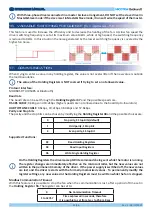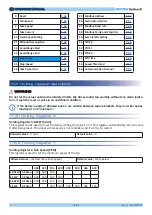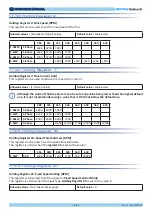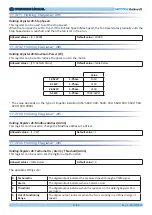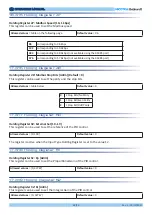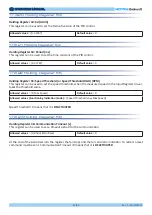
Rev. 1 - 05/10/2021
OPERATING MANUAL
OPERATING MANUAL
EN
EN
34/56
10.4 PID closed control loop
Through this setting the fan can work in a PID closed control loop where the measured process variable is
connected to the TRANSDUCER INPUT that can be monitored through the
Input Register 31.
and it must be in the range of [0,10V]. The PID mode can be therefore used with temperature probes, pressure
transducer, CO/CO2 detectors, etc.
The parameters to set are:
- K
P
= Proportional Gain ->
Holding Register 51
- K
l
= Integral Gain ->
Holding Register 52
- K
D
= Derivative Gain ->
Holding Register 53
- Time = T
PID
->
Holding Register 54
The following equations represent the simplified PID code:
Chapter 5 of the technical Annex to this manual describes a practical procedure to calibrate the PID constants,
to achieve stable operation of the closed-loop PID control system.
As an alternative, the Nicotra Gebhardt Fan Configurator software for PC is also including an automatic pro-
cedure to calibrate the PID controller. In many cases, this software function can save the user from a lengthy
manual calibration procedure. For further information, refer to the Fan Configurator manual.
10.4.2 Modbus temporary ref. PID closed control loop
(INPUT TYPE = 11)
In this mode the PID reference is defined by modifying the
Holding Register 66.
The value of the reference is expressed in steps of 0.1 Volt (therefore the register ranges from 0 to
100) The PID error is calculated in the following way:
Error = (Modbus
REG_66
- ANALOG
Input
)
10.4.3 Modbus fixed ref. PID closed control loop
(INPUT TYPE = 11)
In this mode the PID reference is defined by modifying the
Holding Register 50.
The value of the reference is expressed in steps of 0.1 Volt (therefore the register ranges from 0 to 100) The
PID error is calculated in the following way:
Error = (Modbus
REG_50
- ANALOG
Input
)
10.4.1 Analog ref. PID closed control loop (for 3-phase only)
(INPUT TYPE = 10)
In this mode the PID reference is given by the analog signal present at the ANALOG INPUT that can be moni-
tored through the
Input Register 29.























